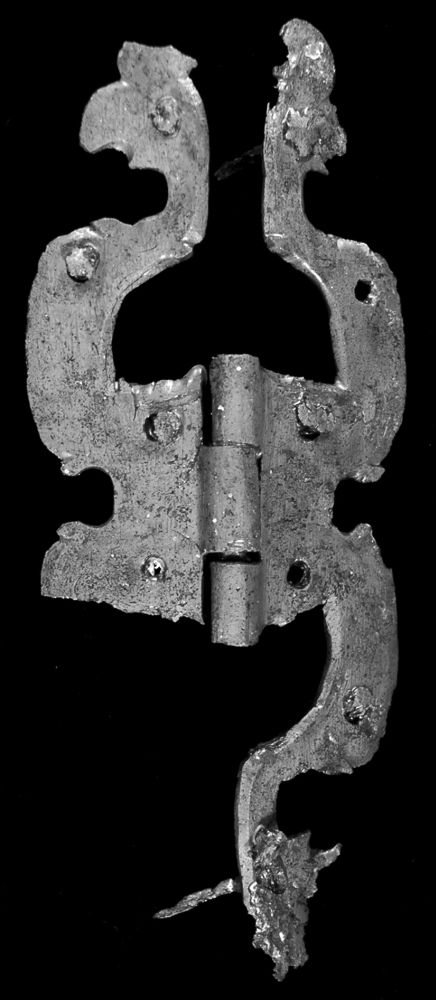The Archaeology of 1690: Status and Material Life on New England’s Northern Frontier
EMERSON W. BAKER
IN THE EARLY 1680s two of the leading merchants of southern Maine engaged in a gentlemanly negotiation. Major John Davis of York, the Deputy President of the Province of Maine, desperately wanted Lt. Humphrey Chadbourne Jr.’s fine gray riding horse. Chadbourne, a wealthy sawmill owner in Berwick, at first refused Davis, claiming the stallion was his wife’s, and she enjoyed riding him. Davis insisted that “he must have the horse” so the major gave Chadbourne his case of pistols in return for the steed. Furthermore, the elderly Davis promised that upon his death, the stallion would be returned to the lieutenant. Less than a month after Davis’s death in October 1691, Chadbourne went to court to reclaim his prize mount. By this time, the horse had become one of his few remaining assets. In the spring of 1690 Humphrey’s extensive complex including a mansion house, a large farm, and a sawmill were all destroyed by a combined French and Native force in the Salmon Falls raid, one of the early encounters of King William’s War. Chadbourne had been virtually wiped out. The court took the matter under advisement. Unfortunately, before Chadbourne could get his stallion back, York also fell victim to a raid. In the Candlemas attack in January 1692 Wabanaki raiders killed or took captive about 120 residents, slaughtered livestock, and burned most of the town. It is likely that Chadbourne’s fine gray stallion was one of the victims of Candlemas. The once wealthy merchant died insolvent three years later.1
The fate of Humphrey Chadbourne Jr. and his horse exemplifies the opportunities and dangers of life on New England’s northern frontier. It was a place where people had the chance to better themselves, but there were substantial risks and few would ultimately achieve wealth and position. Most of the residents of the region were poor farmers, fishermen, and lumbermen who struggled to survive. They labored to harvest the resources that merchants would grow wealthy upon through their participation in the Atlantic trade. Davis, Chadbourne, and their colleagues would in turn draw upon this wealth to acquire their large tracts of land, build mansions, and purchase stallions, pistols, and other fine objects that were important visible reminders of the gulf between this rising would-be gentry class and their less prosperous neighbors. Such markers were clearly important in the newly established and fluid society of the colonial frontier.
The huge losses of the Chadbournes and others in King William’s War (1688–1697) were an utter disaster for them, but a bonanza for present-day archaeologists. The rapid destruction of the northern frontier of English settlements by the Wabanaki and their French allies has left a series of archaeological “time capsules”—sites that were rapidly destroyed and abandoned. Archaeological work at several sites of this era provides a unique opportunity to examine the range of society and economy in coastal New England in the late seventeenth century, and to see just how important material possessions were in differentiating social rank in English settlements.
The primary site under consideration is Chadbourne’s substantial homestead and merchant complex in Berwick (present-day South Berwick, Maine). The author directed thirteen seasons of excavation at the site (1995–2007). During the Salmon Falls raid the Chadbournes were forced to leave almost all of their possessions behind them, and it is a substantial array of finds—over 40,000 artifacts. From fancy door hardware to silver spoons and brass spurs, the assemblage is a conspicuous display that amazes archaeologists today just as it was meant to impress neighbors and servants 300 years ago.2
The Chadbournes belonged to the rising merchant elite of early New England. Humphrey Chadbourne Sr. migrated from Tamworth, Warwickshire, to the Piscataqua in 1634. He initially worked with his father to build and operate a sawmill for Captain John Mason on the present-day Great Works River. Ironically, while Mason was the leading investor in the new colony of New Hampshire, the sawmill was actually located just outside the bounds of his colony, in what would become the Province of Maine. The mill soon ceased operations but Humphrey remained in the area and in 1643 he purchased a large tract of land at the confluence of the Great Works and Salmon Falls River from the local Wabanaki sachem, Mr. Rowls. Here Chadbourne established himself as a merchant and fur trader. The construction of his sawmill in 1652 greatly expanded his operations and wealth.3
Humphrey’s growing prosperity was also aided by a very favorable marriage. About the time he constructed his mill, Humphrey married Lucy Treworgy, a member of one of the leading merchant families of Devon, England, as well as the Piscataqua. Indeed, the town of Kittery, Maine, is named after the home, wharf, and warehouses of Lucy’s grandfather, Alexander Shapleigh, which were located on Kittery Quay, in Kingsweare, Devon. Kittery Quay lies across the River Dart from the busy West Country port of Dartmouth. Lucy’s uncle Nicholas Shapleigh, a prominent royalist, controlled the family merchant and sawmill interests in the Piscataqua. Living a few miles downriver from the Chadbournes on a large estate in present-day Eliot, Maine, Nicholas was a sometime business partner of Humphrey Chadbourne. Numerous artifacts from the West Country are found on the Chadbourne site, suggesting the family maintained these important trade ties to home. Pottery finds include North Devon gravel tempered wares and sgraffittos, as well as Totnes ware—a rare find on early New England sites. Its presence at the Chadbourne site is explained by its manufacture in Totnes, just a few miles up the Dart from Kittery Quay.4
Archaeological work on the Chadbourne site has focused on the mansion house compound, and several nearby outbuildings. The core of the house was raised in 1664. This date is known from dated window leads, a brick marked “64”and a 1662 oak tree twopence discovered in close proximity to the location of the threshold of the front door. Humphrey Chadbourne died in 1667, leaving an estate of over £1,700, making him one of the wealthiest men in northern New England. His probate inventory confirms the archaeological evidence of a two-story hall and parlor house with rear lean-to. Sometime later, another room was added off the parlor, making for a dwelling measuring 42´ x 60´. This mansion house was connected to another domestic unit by a palisade and fencing, creating an enclosed compound, with central courtyard. A barn and dairy were located to the north of the compound, and the sawmill stood to the south, along the banks of the Salmon Falls River. After Humphrey’s death, the house and 400 surrounding acres passed to his wife, Lucy, and his eldest son, Lieutenant Humphrey Chadbourne Jr. The Wabanaki burned the entire complex in March of 1690 during the Salmon Falls raid.5
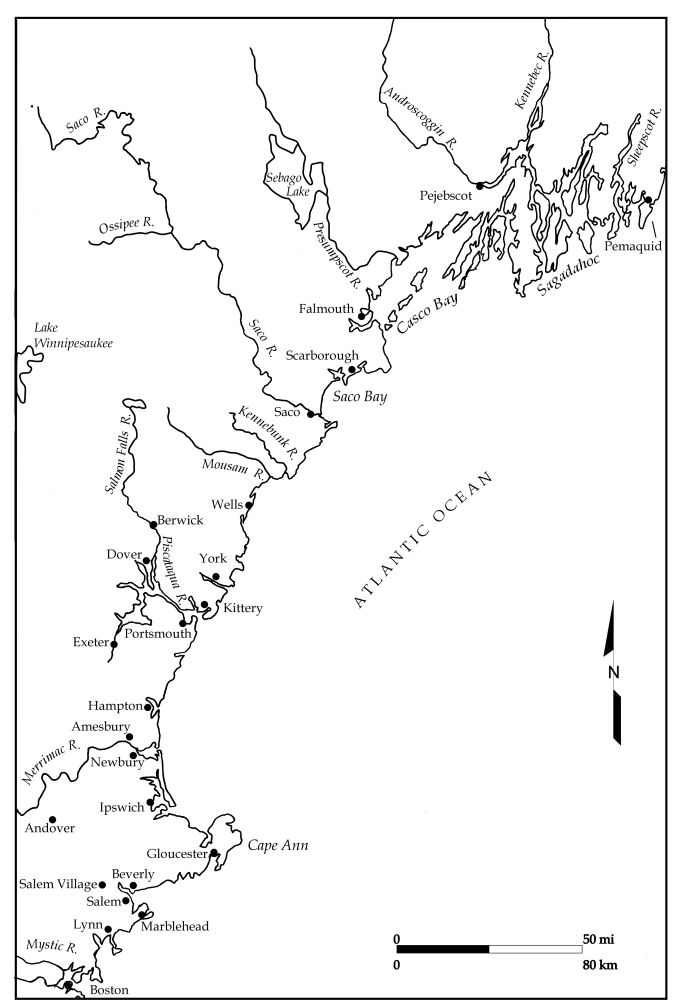
Fig. 1. Coastal Northern New England in the late seventeenth century.
Humphrey and Lucy Chadbourne were people on the make. They came to America with the goal of bettering themselves—of becoming members of the gentry. Virtually all of their actions were geared toward this objective. They constructed a manor house on a huge landed estate that was worked by numerous servants. Family members held high political office, and intermarried into prominent families. They employed high status markers in their dress and many expensive possessions. In all of these ways, the Chadbournes sought to distance themselves from their servants and neighbors. Perhaps their location on the untamed New England frontier, far from the estates of England, made it particularly important to visibly demonstrate their wealth for the Chadbournes. As such, their possessions offer an impressive study of the significance of status in objects in early Maine.
Anyone aspiring to become members of the landed gentry needs an estate, and the Chadbournes did indeed build an impressive stand of buildings. The homestead, barn, and outbuildings sat on 400 acres and was valued at £350. The family sawmill, which was appraised at £300, stood nearby. The mansion had a commanding presence, sitting high on a hill, overlooking the confluence of two rivers. It was meant to be seen. It was big and showy—complete with a very rare plastered parlor. Expensive imported hardware went into the house, including cock’s head hinges, fancy locks, and many glass windows. The house was part of a courtyarded compound, a formal space—no artifact scatter has been found here, not even outside the front door, or windows. In addition, the compound included a second domestic unit, perhaps occupied by the Chadbourne servants, for when Humphrey died in 1667 his probate inventory includes five indentured servants. A barn was located out behind the house, as well as what appears to be a dairy. This large, impressive stand of buildings is a fairly unique discovery for early New England, but it is just one of many signs of the Chadbournes’ wealth.6

Fig. 2. Silver spoon from the Chadbourne site, made by John Hull and Robert Sanderson. 7½ inches in length. Old Berwick Historical Society Collection, South Berwick, Me.
Objects made out of precious metals have always served as important status markers, and the Chadbournes were no exception. Silver was incredibly rare in seventeenth-century Maine, yet excavations at the Chadbourne site recovered one complete silver spoon as well as a silver spoon handle. The complete specimen was made by the first American silversmiths, John Hull and Robert Sanderson. The Boston silversmiths engraved the spoon with the monogram “HLC” so there would be no mistaking that it belonged to Humphrey and Lucy Chadbourne. Humphrey’s 1667 probate inventory included £16 in silver, including his “great silver beaker” that he specifically bequeathed to his young daughter Alice and was to be “quietly delivered unto her at the day of her marriage.” Silver objects show up in only a handful of Maine estates of the era, including two of Humphrey’s kinsmen. Brother-in-law Thomas Spencer’s 1681 inventory lists a silver cup and spoon, and Nicholas Shapleigh’s 1682 inventory included £21 of silver.7
A considerable quantity of fine imported ceramics complimented the silver on the Chadbournes’ table. Excavations recovered fragments of a minimum of twenty tin-enameled vessels, as well as combed-wares, and several nice German stonewares. Tin-enameled wares were the finest European ceramics of the day. Hand-painted earthenware in a variety of colors and finished with a shiny white glaze, these wares were meant to imitate expensive and hard to find Chinese porcelain. They were manufactured across Europe, and called delft, faience, or majolica. Although most New Englanders of moderate wealth owned at least a piece or two of English delft, as wealthy merchants the Chadbournes had access to the best and latest ceramics, and the means to afford them. Consider their fancy lobed plate, or their Bleu Persan (or Persian Blue) plate, an English imitation of a ware made in Nevers, France, which in turn imitates a Persian ceramic. Striking and quite rare in its day, Bleu Persan was also the height of fashion in the 1690. Equally in fashion would have been their English delft plate decorated in the Chinese Scholar pattern, an early expression of chinoiserie that was first made in the 1680s. While most families reserved their tin-enameled wares for use at the table, a polychrome tin-enameled pitcher was recovered in what is believed to have been the Chadbourne barn.8
As merchants who sold lumber in the Caribbean and participated in the wider Altantic trade, the Chadbournes owned many non-English tablewares. They owned at least three different patterns of Portuguese majolica, or Lisbonware. When Humphrey’s sister and next-door neighbor Patience Chadbourne Spencer died in 1683, her “lisborne dishes” are specifically mentioned three times in her probate inventory. While other residents of Maine owned an occasional piece of Lisbonware, no one could match the Chadbournes’ set of at least four hand-painted platas (or plates) made of Aucilla polychrome ware, manufactured in Mexico City. These are the first confirmed seventeenth-century Spanish colonial tablewares found north of the Chesapeake—a truly unique adornment for the Chadbourne table that would have impressed all dinner guests. Presumably acquired through their Caribbean lumber trade, the platas must have been purchased clandestinely, for it was illegal for the English to trade with the Spanish.9
The Chadbournes showed their rank in their dress and adornment as well, in such objects as a hand mirror with an ivory handle. Few clothing related artifacts survive, though excavations found three passmenterie buttons—two made with silver wound thread. Other striking status markers are the Chadbournes’ horse furniture. Two spurs have been found; one is iron with a brass rowell, while the second is a highly decorated brass spur. The harness of Humphrey Chadbourne Jr.’s fine stallion was decorated with a large brass Tudor rose boss. In the late seventeenth century this was a badge of loyalty to the royalist cause of the Stuart monarchy. At a time when streets were rare in Maine and oxen pulled plows, horses were a true luxury item. Riding a fine stallion with elaborate brass spurs and a decorated harness across the rugged Maine countryside, Humphrey Jr. would have been a mobile statement of authority and wealth. In his 1667 will Humphrey Sr. bequeathed “to my son Humfrey Chadbourne my now riding horse with all the furniture to him belonging, and my intent is that the said horse with ye furniture bee at his owne dispose, immediately after my decease.” Clearly father and son recognized the power of this symbol of authority and status, and the importance of its maintenance and immediate transfer from one generation to the next.10
The symbolism certainly would not have been missed by Humphrey Jr.’s wife, Sarah Bolles Chadbourne, who was a descendant of King Edward I (1239–1307; king 1272–1307). Sarah’s father, Joseph, was a gentleman, born at his parent’s estate of Oberton Manor, in Nottinghamshire. Joseph had been an early immigrant to the Province of Maine, a high officeholder and a leading citizen of Wells. Today the term gentleman has little true meaning but in the seventeenth century it was reserved for people of wealth and position. Joseph Bolles was one of the few gentlemen to take up residence in Maine. Bolles’s daughters were probably the only young ladies in Maine of known royal descent. Possessing wealth and status, but lacking noble blood, it should come as no surprise that young Humphrey Jr. married one of the Bolles girls, thus bolstering the claim of gentleman status for himself and his descendants. The marriage also allied him with another prominent merchant family, for Sarah’s oldest sister was married to Major Charles Frost, another of the leading magistrates and merchants in southern Maine.11
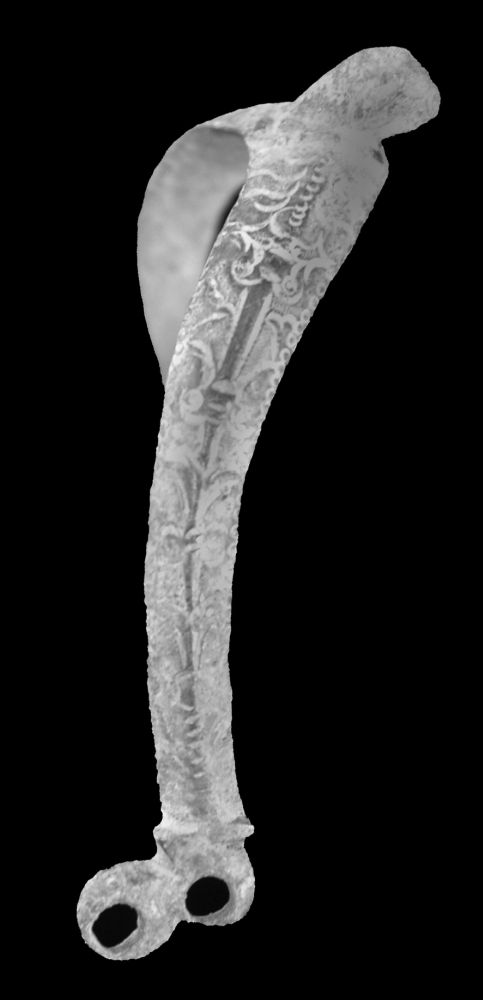
Fig. 3. Brass spur from the Chadbourne site. Old Berwick Historical Society Collection.
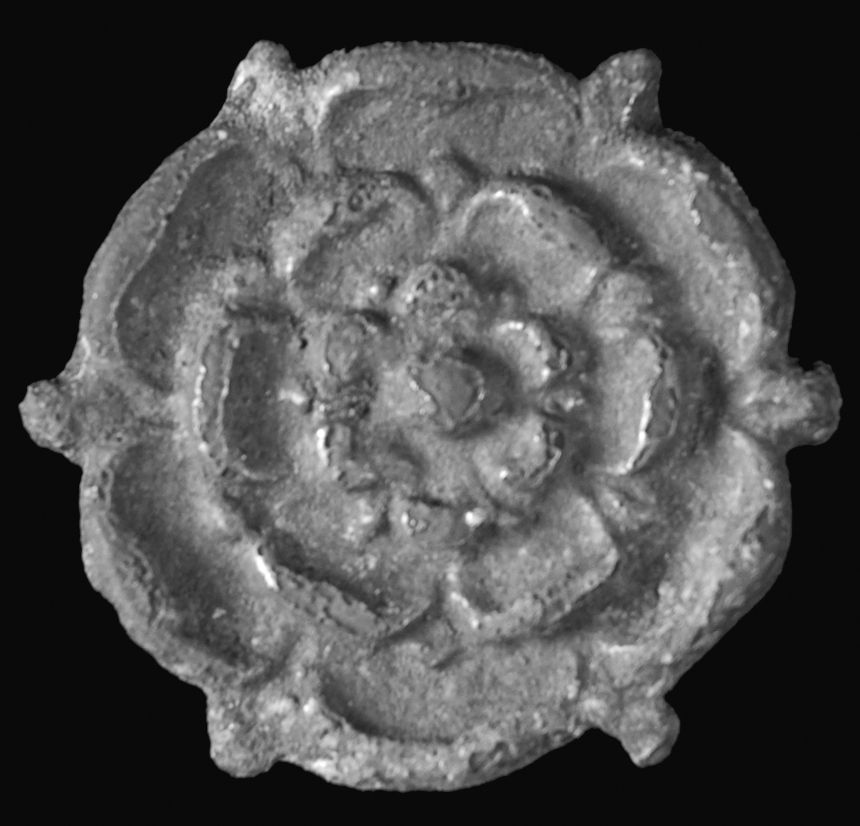
Fig. 4. Brass harness boss with Tudor Rose medallion from the Chadbourne site. 1½ inches in diameter. Old Berwick Historical Society Collection.
The Chadbournes, their possessions, and their quest for status demonstrate the process Richard Bushman has called “the refinement of America.” This evolution of polite society was reflected in changes in everything from speech and manners to houses, clothing, and ceramics. Bushman suggests this push for gentility began in America around 1690, yet the evidence from the Chadbournes suggests the process was well underway by that date for them, their fellow elites, and at least some of the middling sort of the region.12
Archaeological data from contemporary sites as well as probate inventories provides supporting evidence for the beginnings of this process of refinement. The author has directed excavations at two other Maine sites that were destroyed at the outbreak of King William’s War: the fortified fishing station on Sagadahoc Island at the mouth of the Kennebec River and a coastal farmstead owned by the Hitchcock family at Biddeford Pool. When considered along with the Chadbourne excavations, the sites are distributed from one end of early Maine to the other, and range from poor fishermen to yeoman farmers and merchant elites. In addition to these domestic sites, the excavation of the wreck of the Elizabeth and Mary adds another perspective. This ship, full of Dorchester, Massachusetts, militiamen, lost on Sir William Phips’s ill-fated 1690 invasion of Quebec, was recently excavated by Parks Canada and the Province of Quebec. Together these sites provide a view of material life in late seventeenth-century New England.
The artifacts from the Chadbourne site are closest to those from the Elizabeth and Mary. This is not surprising, given that the officers of the Dorchester militia were prosperous merchants who had many similar high status artifacts. They wore silver brooches and shoe buckles and silk ribbons and passmenterie buttons. Such luxury items as an exotic wassail cup made of lignum vitae and a brass, tin-covered three-tined fork would have been noteworthy in Dorchester, and must have truly stood out onboard a troop ship. No sword hardware was recovered at the Chadbourne site, but one suspects that Lieutenant Humphrey would have owned a fancy sword, similar to the ones found on the Elizabeth and Mary, that included a sword grip with elaborate silver wire wrap, and brass counterguards with classical or floral decoration.13
The Hitchcocks were yeoman farmers, not wealthy merchants from Dorchester or the Piscataqua. Richard Hitchcock arrived in Saco by 1636, starting with a very modest estate. He rose to become a civic leader and a man of moderate wealth, leaving an estate valued at £278 at the time of his death in 1671. His heirs left behind an assortment of fine possessions when they abandoned the home during a Native American raid in the spring of 1690. Although the Hitchcocks owned earthenware that was much smaller in number and value than the Chadbournes, they owned a minimum of eight pieces of English delft tableware that were found, including three fancy lobed plates, two bowls, and a porringer. Two plates have early Chinoserie decoration—very fashionable in the 1680s. The finds also include parts of at least three combed yellow cups, a Westerwald mug, three Bartmann jugs, and a North Devon Sgraffitto plate. That is a minimum of sixteen pieces of tableware, most of it in use at the time the house burned down.14
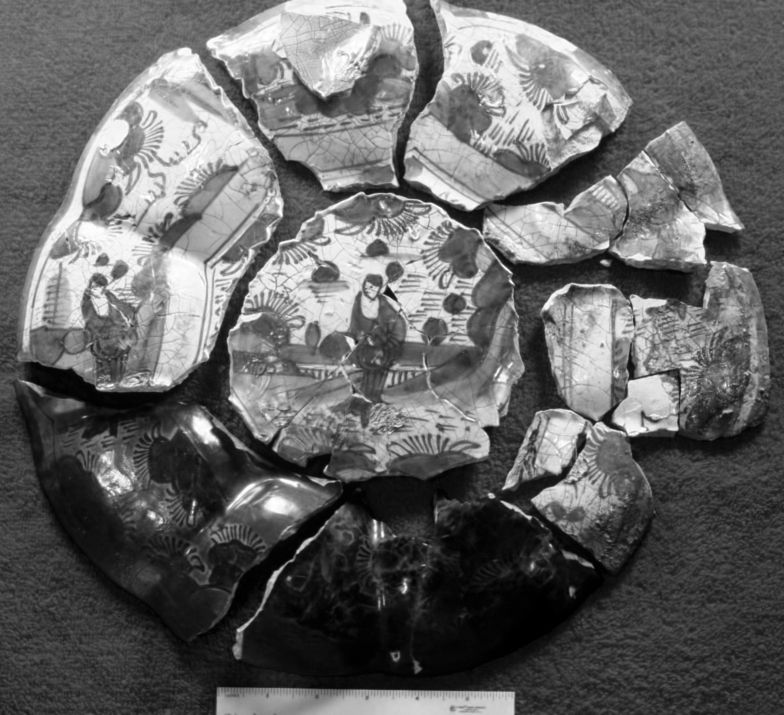
Fig. 5. English lobed delft plate with chinoiserie decoration, burned and broken in the destruction of the Hitchcock homestead in 1690. Saco Museum Collection, Saco, Me.
Richard Hitchcock’s family possessed quite a few articles of clothing and personal possessions, a fact supported by the inclusion of four chests in his 1671 probate inventory and in the excavation of five chest or trunk locks. In a time before houses had closets, chests and trunks held textiles and other valuable possessions. A part of the face of a brass sundial was also excavated, presumably a rare and cherished possession. And, as befitting a militia officer, his inventory included a gun, a sword, and even a mare. However, the excavation of a pair undecorated iron stirrups suggests Lieutenant Hitchcock would have commanded a much less impressive presence than Lieutenant Humphrey Chadbourne Jr. The same can be said overall for the Hitchcocks. They were a yeoman farming family who had prospered in Maine, and owned a few fine possessions to reaffirm their status, which certainly was higher than their fisherman neighbors at Biddeford Pool. However, they would definitely take a back seat to the Chadbournes and other merchant elites. Still, the growing prosperity and number of status objects enjoyed by yeomen such as the Hitchcocks meant that elites had to go to extra lengths to reaffirm their own economic, political, and social leadership. The Hitchcocks’ pewter plates would be no match for Chadbourne silver.15
About thirty miles northeast of the Hitchcock homestead lay Sagadahoc Island, a fishing station at the mouth of the Kennebec River, near the eastern edge of English settlement in early Maine. Occupied as early as the 1640s, it saw its most intensive use from 1680 to 1689 when it was reoccupied and fortified by the poor fishermen of the Kennebec who had been forced out of the region during King Philip’s War. Artifact density is very high, reflecting intense occupation of a small site. The objects themselves tend to be relatively pedestrian—numerous tobacco pipe fragments and pieces of redware. Still, pieces of tin-enameled wares, combed-yellow slipwares, North Devon sgraffitto, and even German stoneware were present in very small quantities. The Chadbournes had far more extensive and expensive high status objects than the fishermen of Sagadahoc Island. Yet even these poor men possessed an occasional nice item. Once shipments arrived in Massachusetts ports, new fashionable goods quickly spread into all New England households. Take the example of combed-yellow slipware. This ware was first manufactured in England in 1670, but there is no evidence of its arrival in Maine until after King Philip’s War. So, in the 1680s it was a stylish new tableware for New Englanders. Combed-yellow slipware was in active use on all three Maine sites and on board the Elizabeth and Mary in 1689–1690.16
Combed-yellow slipware is just one of many objects common to these sites. Most of the artifacts from the Elizabeth and Mary look like they could have walked right off the Maine sites. The type, quality, and range of goods available to people in Dorchester, within the urban core, were apparently just as accessible to people on the Maine frontier. All you needed was the credit to purchase them. This similarity is not surprising, considering that all the sites in Maine are located on navigable water, which is at most a two-day sail from Boston—areas regularly visited by the Essex County fishing fleet. Also, many Massachusetts merchants had operations and trading partners in Maine, so the same goods they marketed to residents of Dorchester were also shipped to Maine for sale. For example, Samuel Sewall, one of the wealthiest Boston merchants of the day, owned a sawmill roughly a mile up the Salmon Falls River from the Chadbourne site. The artifacts suggest that by 1690 Boston has clearly established its regional economic hegemony, creating a fairly uniform access to and distribution of most goods throughout the region. As early as 1672, Scarborough resident John Josselyn complained that “shopkeepers there are none, being supplied by the Massachusetts with all things they stand in need of . . . but they set excessive prices on them.”17
There is one noticeable difference in artifacts between the Maine sites and the Elizabeth and Mary. The Maine sites all have the presence of West Country artifacts, while the shipwreck does not. North Devon gravel tempered wares and sgraffito wares were recovered at all three Maine sites. All of these sites also have a very strong presence of Bristol-made tobacco pipes, particularly those made by the Evans family. Maine had significant ties to the West Country in the seventeenth century. The Shapleighs were among many early settlers who came from Cornwall, Devon, and Somerset. Even the Proprietor of Maine, Sir Ferdinando Gorges, lived in Plymouth, Devon, and had an estate in Bristol. West Country ships traded directly with Maine, and indirectly through Newfoundland. Although West Country ceramics and Bristol pipes are found in excavations throughout the English colonies, their strong presence in these Maine sites suggests the region may have maintained some of these trade ties into the late seventeenth century. They did so despite the growing dominance of Massachusetts merchants who tended to have strong connections to London rather than Bristol.18
Fig. 6. Broken cocks head door hinge from the Chadbourne site. 8¼ inches in length. Old Berwick Historical Society Collection.
The residents of Maine had common sources for their material goods, even if the wealthy elites could distance themselves by purchasing more fancy objects. Yet, when you scratch their veneer of gentility, people like the Chadbournes had more in common with their neighbors than first appears. The Chadbourne mansion is a study in opposites. It is large and impressive, adorned with many windows, and fancy imported hardware, such as cocks head hinges. Great expense went into the windows the thousands of nails, as well as the hundreds of bricks used to make two substantial chimneys. The plastered parlor must have been one of the earliest in New England, a real rarity on the Maine frontier. Yet, the mansion was largely of earth-fast construction. Only the front wall of the cellar was stoned, with the remaining three sides being wood-lined. Parts of the building employ earth-fast posts, buried sill construction, and sill on grade. Aside from the mansion, the rest of the Chadbournes’ stand of buildings was entirely earth-fast. Here the Chadbournes had much in common with the Hitchcocks and the fishermen of Sagadahoc Island, for all the structures at these sites were completely earth-fast. Even the two cellars under the Hitchcock home were wood-lined and held in place with earth-fast posts.
Earth-fast, or “post-in-ground” construction has been defined as buildings with framing members “standing or lying directly on the ground or erected in post holes.”19 Esentially it is construction that does not use a stone or brick foundation. First recognized as the prevailing form of construction in the Chesapeake in the seventeenth century, more recently it has been seen as a common form of architecture in early northern New England. Indeed every seventeenth-century Maine site found in the past twenty-five years is least partially earth-fast. This was a traditional English practice that required relatively minimal work by trained carpenters, and needed no stone mason. This technique remained popular because it was quick, cheap, and minimized the need for skilled labor in a land where such talents were in great demand. John Josselyn complained that “handcraftsmen there are but few, the tumelor or cooper, smiths and carpenters are best welcome.”20
Why did the Chadbournes employ earth-fast architecture? Rather than distancing themselves from their less well-off neighbors, it gave them the common ground they sought to avoid. Not only was Humphrey Sr. a carpenter, but he also kept indentured servants. For example, five are included in his 1667 probate inventory. Furthermore, the site is littered with lumbering and carpentry tools, ranging from hammers and saws to axes and draw knives. Humphrey Chadbourne probably chose earth-fast construction for several reasons. First, there were probably limits to even his available supply of labor, especially when the entire 30´ x 42´. core of the house was raised at one time. Running a sawmill and lumbering operation required extensive labor, and only so much could be spared. And, given the fact that Chadbourne owned a sawmill, it would be easy to get lumber to repair the rot that eventually resulted from earth-fast construction. Furthermore, given its practicality and widespread use among all ranks of society, it seems doubtful that it would have the negative connotations associated with it today, when it is called “impermanent architecture.” Anyone visiting the Chadbourne estate would have been impressed by the enormous sums of money and labor expended on the construction and embellishment of the mansion house and outbuildings. Nor could anyone doubt that the Chadbournes intended for themselves and their would-be manor to be permanent fixtures on the Maine landscape. The necessities of life on the frontier meant they may have cut some corners in the construction of the home, but these tended to be well hidden and thus easily missed by the casual observers.21
In some ways, the Chadbourne house is symbolic of the young society that was evolving in Maine during the seventeenth century. Large and striking, the Chadbourne residence was hastily constructed using the minimal standards of the day. Well appointed with expensive hardware and brick and plaster, it was designed to impress the Chadbournes’ workers and neighbors, and to reinforce their leading position in the evolving frontier society of northern New England. It was a house and a culture built upon the rapidly acquired wealth of the frontier, with a promise of more to come, along with growing status and power. Yet, not enough care had gone into the construction of this society. In the late seventeenth century the rotten foundation quickly gave way under the weight of war, leading to the collapse of the entire edifice. By early 1692, almost all the English settlements of Maine had been abandoned with just a few hundred settlers clinging to hope in the southernmost settlements. Not until a generation of warfare ended in 1713 would people be able to return to Maine and build society anew.

